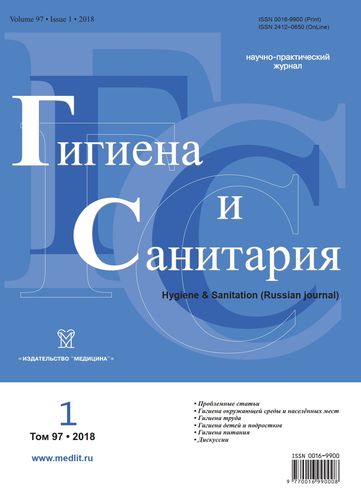Hygenic assessment of dynamics of chloroform exposition in Perm region and it's impact on causing diseases of the blood, blood-forming organs and certain disorders involving immune mechanism among children
- Authors: Chetverkina K.V.1, Kleyn S.V.1, Chigvintsev V.M.1
-
Affiliations:
- Federal Scientific Center for Medical and Preventive Health Risk Management Technologies
- Issue: Vol 97, No 1 (2018)
- Pages: 29-34
- Section: ENVIRONMENTAL HYGIENE
- Published: 14.10.2020
- URL: https://ruspoj.com/0016-9900/article/view/640309
- DOI: https://doi.org/10.47470/0016-9900-2018-97-1-29-34
- ID: 640309
Cite item
Full Text
Abstract
On the basis of the system review, the relevance of the problem of the chloroform content in the drinking water of centralized drinking-water supply systems in the Perm Territory is confirmed. The comparative characteristic with the average Russian indices is presented. Insufficient volume of information containing data on the impact of the oral intake of chloroform on the blood system was established. There are presented results of the research content of chloroform in water samples from centralized drinking water supply in the cities of Perm region, as well as in the blood of the child population aged from 3 to 13 years living in these areas and consuming water under investigation in the period from 2011 to 2015. A long-term dynamics of the content of chloroform, contained in samples of drinking water and in bio-environments is described. A mathematical simulation of the dependence of the chloroform content in the blood as an exposure marker on the concentration of chloroform in water was carried out. As a result of the analysis of the prevalence rate of diseases of the blood system, hematopoietic organs and certain disorders involving the immune mechanism in the child population, there was established the relevance of differences between the territories of Permsky Krai with surface and underground water supply. The dynamics of the chloroform content in water and morbidity according to the class of blood diseases, hematopoietic organs and certain disorders involving the immune mechanism is presented and described. The association between the exposure to the oral intake of chloroform with drinking water with a morbidity on the class of diseases of the blood system was established on the basis of constructing a mathematical model. The conclusion about the legitimacy of information on the effect of the oral intake of chloroform on the blood system, hematopoietic organs and certain disorders involving the immune mechanism is presented.
Keywords
About the authors
Kristina V. Chetverkina
Federal Scientific Center for Medical and Preventive Health Risk Management Technologies
Author for correspondence.
Email: romanenko@fcrisk.ru
Postgraduate student, specialist for risk assessment of the laboratory of methods for analysis of external environmental risks of the department of health risk analysis of the Federal Scientific Center for Medical and Preventive Health Risk Management Technologies, Perm, 614045, Russian Federation.
e-mail: romanenko@fcrisk.ru
Russian FederationS. V. Kleyn
Federal Scientific Center for Medical and Preventive Health Risk Management Technologies
Email: noemail@neicon.ru
Russian Federation
V. M. Chigvintsev
Federal Scientific Center for Medical and Preventive Health Risk Management Technologies
Email: noemail@neicon.ru
Russian Federation
References
- White G.C. White’s Handbook of Chlorination and Alternative Disinfectants. Hoboken: Wiley; 2010
- May I.V., Sharifov A.T., Silina D.V. Health and hygiene problems of Perm region urban territories with drinking water supply from surface sources. Vestnik Permskogo natsional’nogo issledovatel’skogo politekhnicheskogo universiteta. Prikladnaya ekologiya. Urbanistika. 2012; (1): 115-23. (in Russian)
- Krasovskiy G.N., Egorova N.A., Bykov I.I. Classification of hazards of water pollutants. Gigiena i sanitariya. 2006; 85(2): 5-8. (in Russian)
- Bazhenova L.N. Organic Superecotoxicants. Analytical Aspect: Lecture Course [Organicheskie superekotoksikanty. Analiticheskiy aspekt: Kurs lektsiy]. Ekaterinburg; 2007. (in Russian)
- Onishchenko G.G., Zaytseva N.V, Zemlyanova M.A. Identification of Health Effects Caused by Environmental Chemical Exposure [Gigienicheskaya indikatsiya posledstviy dlya zdorov’ya pri vneshnesredovoy ekspozitsii khimicheskikh faktorov]. Perm’; 2011. (in Russian)
- Egorova N.A., Bukshuk A.A., Krasovskiy G.N. Hygienic assessment of drinking water chlorination by-products in view of multiroute exposure. Gigiena i sanitariya. 2013; 92(2): 18-24. (in Russian)
- Shafy M.A., Grunwald A. TGM formation in water supply in South Bohemia, Czech Republic. Water Res. 2000; 34(13): 3453-9.
- Gulati D.K., Hope E., Mounce R.C., Russell S., Poonacha K.B. Chloroform reproduction and fertility assessment in CD-1 mice when administered by gavage. Research Triangle Park, NC: National Toxicology Program, National Institute of Environmental Health Sciences; 1988.
- Bull R.J., Brown J.M., Meirerhenry E.A., Jorgenson T.A., Robinson M., Stober J.A. Enhancement of the hepatotoxicity of chloroform in B6C3F1 mice by corn oil: Implications for chloroform carcinogenesis. Environ. Health Perspect. 1986; 69: 49-58.
- Hardman J.G., Limbird L.E., Gilman A.G. Goodman and Gilman’s The Pharmacological Basis of Therapeutics. New York: McGraw-Hill; 2006.
- WHO. EHC163: Chloroform. Available at: http://www.inchem.org/documents/ehc/ehc/ehc163.htm
- Vogt C.R., Liao J.C., Sun A.Y. Extraction and Determination of Chloroform in Rat Blood and Tissues by Gas Chromatography-Electron-Capture Detection: Distribution of Chloroform in the Animal Body. Clin. Chem, 1980; 26(1): 66-8.
- Luzhetskiy K.P., Shur P.Z., Ustinova O.Yu., Dolgikh O.V., Kir’yanov D.A., Chigvintsev V.M. Individual risk assessment of metabolic disorders in children at exposure to chloroform in drinking water. Analiz riska zdorov’yu. 2015; (4): 28-35. (in Russian)
- Koren H. Handbook of environmental health. Boca Raton: CRC Press, LLC; 2003.
- Glantz S.A. Primer of Biostatistics. New-York: McGraw-Hill; 1994.
- Zemlyanova M. A. Pustovalova O.V., Mazunina D.L., Sboev A.S. Biochemical marker indices of negative impacts in children under the exposure to the chlororganic compounds with drinking water. Gigiena i sanitariya. 2016; 95(1): 97-101. (in Russian)
- Kamilov F.K. Pathochemistry of toxic effects of chlororganic and aromatic compounds. Meditsinskiy vestnik Bashkortostana. 2007; 2(6): 76-80. (in Russian)
- Krasovskiy G.N., Egorova N.A. Chlorination of water as a high hazard to human health. Gigiena i sanitariya. 2003; 82(1): 17-21. (in Russian)
- White G.C. White’s Handbook of Chlorination and Alternative Disinfectants. Hoboken: Wiley; 2010.
Supplementary files









